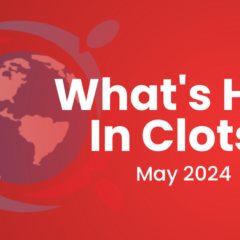Published on
Clot Chronicles: Key Findings From the HEP-COVID Trial
Hello, my name is Alex Spyropoulos. I’m a Professor of Medicine at the Zucker School of Medicine at Hofstra-Northwell, Professor at the Feinstein Institutes for Medical Research, and Assistant Director of Anticoagulation and Clinical Thrombosis Services at Northwell Health in New York. Today, my discussion on Clot Chronicles involves the primary results of the HEP-COVID trial recently presented at the European Society of Cardiology Congress.
HEP-COVID was a multicenter, randomized trial of hospitalized patients with COVID-19 and very elevated D-dimer levels. Patients were randomized into either therapeutic-dose low-molecular-weight heparin (LMWH) versus institutional standard-of-care prophylaxis, which involved mostly either prophylactic or intermediate doses of heparin, including unfractionated heparin and LMWH.
The results of the HEP-COVID trial showed a significant reduction in the composite outcome of major thromboembolism and death favoring the therapeutic-dose group over the standard prophylactic-dose group, with an absolute risk reduction (ARR) of approximately 13% –
translating to a relative risk reduction (RRR) of about 32%. Patients at the time of randomization were stratified as to whether they received ICU-level care or not. The ARR in the non-ICU stratum was closer to 20% with an RRR of 54% – again, a significant difference favoring the therapeutic-dose group.
This was mainly driven by a reduction in major thromboembolism—which included both venous thromboembolism and arterial thromboembolism—showing an approximate 19% ARR or 63% RRR, again, favoring the therapeutic-dose group. In terms of all-cause mortality, although there were no significant differences between groups, there were numerically fewer deaths in the therapeutic-dose group, 25, versus standard-dose group, 31 – and the majority of deaths were cardiovascular in nature.
In terms of the safety profile, there were 8 major bleeds in the entire trial – 2 in the standard-dose group versus 6 in the therapeutic-dose group. In the non-ICU stratum, there were 2 major bleeds in each group. None of these differences were statistically significant and no major bleeds were fatal. As a result, the HEP-COVID trial is the first randomized trial using a classic or traditional thromboprophylactic clinical trial design to show that therapeutic-dose LMWH reduced a composite of major thromboembolism and death compared with institutional-standard heparin thromboprophylaxis without an increase in major bleeding among high-risk COVID-19 patients with very elevated D-dimers.
Of note, a strategy of using very elevated D-dimers enrolled a very high-risk population where the primary outcome was seen in about 36% of non-ICU patients and about 41% in the overall trial population whose risk was nevertheless modifiable by the use of therapeutic-dose LMWH. The treatment effect seen in the HEP-COVID trial was mainly observed in the hospital phase of the trial within 14 days of hospitalization. And there appeared to be no benefit in patients requiring ICU level of care.
So, to conclude, the HEP-COVID trial provides us high-quality evidence that the use of therapeutic-dose LMWH should become the new standard of care for thromboprophylaxis with high-risk COVID-19 patients, showing an ARR of 13% coupled with an absolute incremental major bleed risk of about 3% – again showing a very favorable net clinical benefit with a number needed to treat (NNT) of approximately 8 to prevent 1 major thromboembolic event and death. In the non-ICU stratum, the NNT was 5.
The number needed to harm (NNH) in the overall population was 33, while in the non-ICU stratum, the NNH was approximately 2,000. As such, in conjunction with the recent publication of the multiplatform trials that showed benefit of therapeutic anticoagulation in reducing disease severity, the HEP-COVID trial shows that using a thromboprophylactic strategy, one would see a significant reduction in major thromboembolism and mortality, which would likely produce high-quality evidence to change antithrombotic clinical practice guidelines. Thank you.



